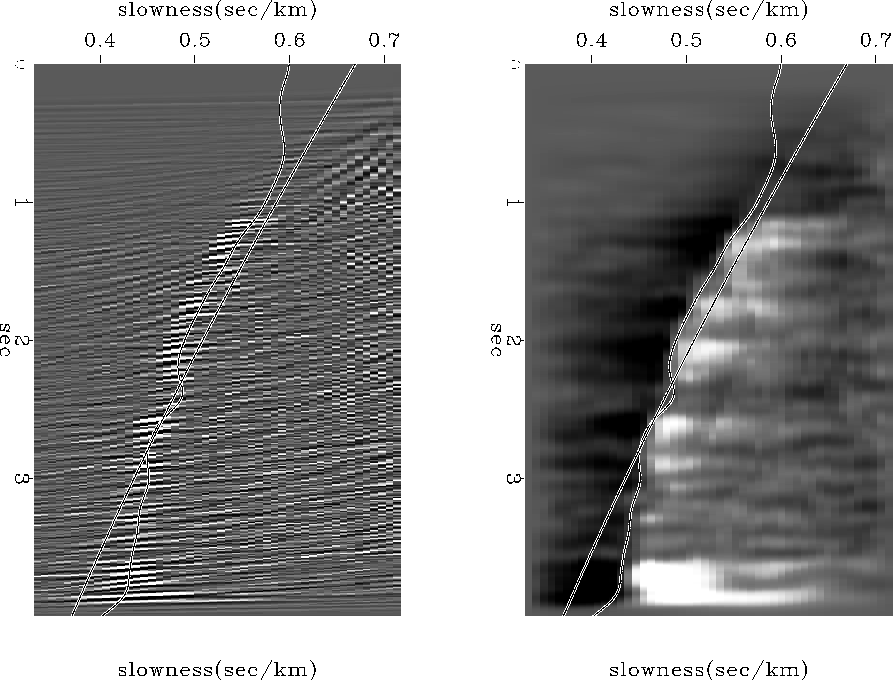For many kinds of data analysis, we need to know the velocity of the earth as a function of depth. To derive such information we begin from Figure 9 and draw a line through the maxima. In practice this is often a tedious manual process, and it needs to be done everywhere we go. There is no universally accepted way to automate this procedure, but we will consider one that is simple enough that it can be fully described here, and which works well enough for these demonstrations. (I plan to do a better job later.)
Theoretically we can define the velocity or slowness
as a function of traveltime depth by the moment function.
Take the absolute value of the data scans and smooth
them a little on the time axis to make something like an unnormalized
probability function, say ![]() .Then the slowness
.Then the slowness ![]() could be defined by the moment function, i.e.,
could be defined by the moment function, i.e.,
| |
(12) |
![[*]](http://sepwww.stanford.edu/latex2html/cross_ref_motif.gif) ).
Experience with Gulf of Mexico data shows that
).
Experience with Gulf of Mexico data shows that
![[*]](http://sepwww.stanford.edu/latex2html/cross_ref_motif.gif) ),
and that is the smooth curve
in Figure 10.
),
and that is the smooth curve
in Figure 10.
Experience with moments,
equation (12),
shows they are reasonable when
the desired result is near the guessed center of the range.
Otherwise, the moment is biased towards the initial guess.
This bias can be reduced in stages.
At each stage we shrink the width of the zone used to compute the moment.
This procedure is used in subroutine slowfit() ![[*]](http://sepwww.stanford.edu/latex2html/cross_ref_motif.gif) which
after smoothing to be described,
gives the oscillatory curve you see in Figure 10.
which
after smoothing to be described,
gives the oscillatory curve you see in Figure 10.
subroutine slowfit( vsurface, alpha, t0,dt, s0,ds, scan,nt,ns, reg, slow)
integer irange, it,is, nt,ns
real num,den, t,s, vsurface, alpha, t0,dt, s0,ds, scan(nt,ns),reg(nt),slow(nt)
do it= 1, nt { t= t0 + dt*(it-1) + dt
reg(it) = 1./( vsurface * sqrt( (exp(alpha*t) - 1.)/(alpha*t) ))
slow(it) = reg(it)
}
do irange= ns/4, 5, -1 { # shrink the fairway
do it= 1, nt { t= t0 + dt*(it-1)
do is= 1, ns { s= s0 + ds*(is-1)
if( s > slow(it) + irange*ds) scan(it,is) = 0.
if( s < slow(it) - irange*ds) scan(it,is) = 0.
if( s > 1./1.6 ) scan(it,is) = 0. # water
}
den= 0.0; num= 0.0
do is= 1, ns { s= s0 + ds*(is-1)
num = num + scan(it,is) * s
den = den + scan(it,is)
}
slow(it) = num / ( den + 1.e-20)
if( slow(it) == 0.) slow(it) = 1./vsurface
}}
return; end
A more customary way to view velocity space is to square the velocity scans and normalize them by the sum of the squares of the signals. This has the advantage that the remaining information represents velocity spectra and removes variation due to seismic amplitudes. Since in practice, reliability seems somehow proportional to amplitude the disadvantage of normalization is that reliability becomes more veiled.
An appealing visualization of velocity is shown in the right side of Figure 10. This was prepared from the absolute value of left side, followed by filtering spatially with an antisymmetric leaky integral function. (See PVI page 57). An example is shown on the right side of Figure 10.
 |